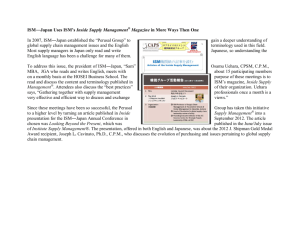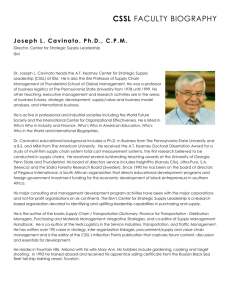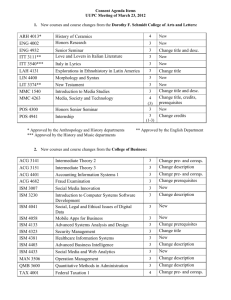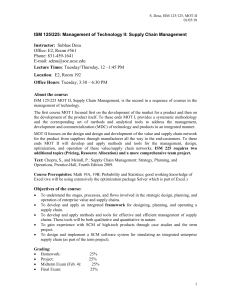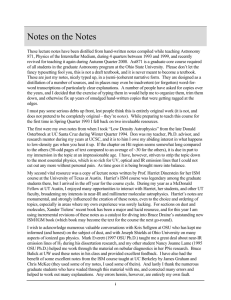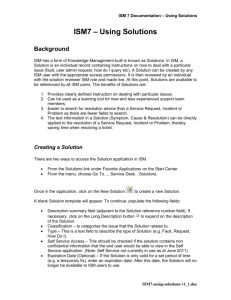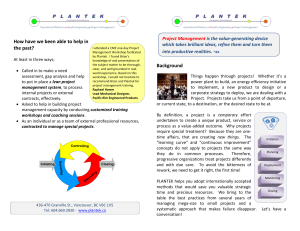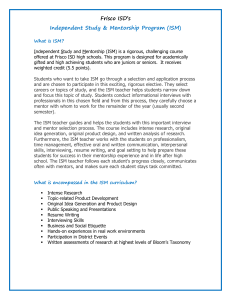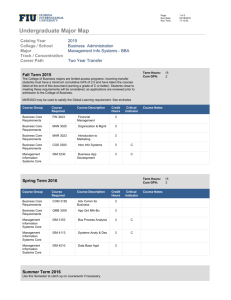ISM Module 4
advertisement
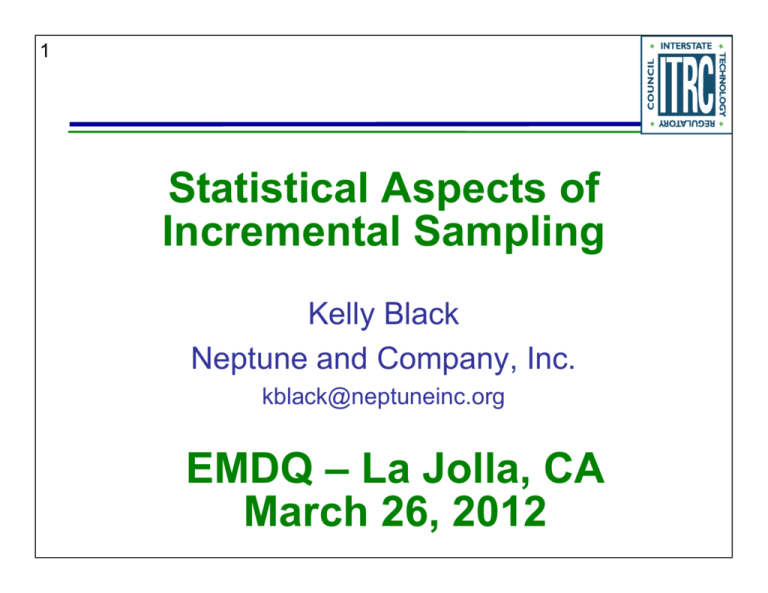
1 Statistical Aspects of Incremental Sampling Kelly Black Neptune and Company, Inc. kblack@neptuneinc.org EMDQ – La Jolla, CA March 26, 2012 2 ISM Document and Training Roadmap Training Module ISM Document Introduction Plan Challenges/ Opportunities Section 8 Principles Section 2 Systematic Planning Section 3 Statistical Design Section 4 Field Implementation Section 5 Lab Processing Section 6 Assess Making Decisions Section 7 Application ISM Opportunities Implement Part 1 Part 2 3 Questions – Data Analysis 1. Does a single ISM sample provide a reasonable estimate of the mean? Section 4.2.1 2. Can a 95UCL be calculated with ISM data? Section 4.2.2 95UCL = 95% Upper Confidence Limit of the mean 4 Questions – Sampling Design 3. What sampling design should I use? Section 4.3.4.2 4. Is it reasonable to assume that concentrations are similar across DUs? Section 4.4.2 5 Questions – Comparison of Data 5. Can background and site data be compared using ISM? Sections 4.4.3.3 and 7.2.4 6. Can ISM data be compared to discrete or composite data? 95UCL = 95% Upper Confidence Limit of the mean 6 1. Does a single ISM provide a reasonable estimate of the mean? Answer: It depends how much error we are willing to accept. Why would someone collect just 1 ISM? • UCL not required by regulator • Save time and expense • Assumption that more samples wouldn’t change the decision. For example Variance among individual increments is low Mean of DU is far above or below an action level ITRC, ISM-1, Section 4.2.1 7 1(b). How “badly” might I underestimate the mean? Probability 60% 40% CV=3.0 CV = 3.0 CV = 2.0 CV=2.0 20% CV = 1.0 CV=1.0 0% CV Frequency 20% 40% 60% Underestimate of Mean Magnitude True Mean 80% Estimate 1 1 out of 4 15% 400 ppm ≤ 360 ppm 1 out of 4 2 25% 400 ppm ≤ 320 ppm 1 out of 4 3 30 - 60% 400 ppm 160 - 280 ppm *Coefficient of variation (CV) = St Dev / mean ITRC, ISM-1, Section 4.2.1, Figure 4-2 8 2. Can a 95UCL be calculated? Answer: Yes, even with as few as 3 ISM samples. Need at least 3 replicates (r ≥ 3) Fewer methods are available than we are used to with discrete sampling: • Student’s-t • Chebyshev Each ISM result provides an estimate of the mean (“x-bar”) Parameter estimates are calculated directly from ISM data 9 2(b). How do I choose a UCL method? Consider performance measures (informed by simulation study) • Coverage (probability UCL > mean) • Magnitude of difference between UCL and mean Recognize the key to performance is variability • Distribution of discretes ≠ Distribution of ISM results 10 Distribution of Means (ISM Replicates) CV = 0.5 f(x) 0 0 250 CV = 2.0 f(x) Concentration Concentration CV = 1.0 f(x) ISM (N=30) 0 Concentration Discrete CV = 3.0 f(x) 250 250 0 Concentration 250 ISM distribution variance is smaller ISM distribution shape becomes more non-normal with increasing CV of discrete distribution ITRC, ISM-1, Figure 4-3 11 Coverage Probabilities Both methods provide desired 95% coverage when variability is low Chebyshev has more consistent 95% coverage for medium and high variability Increasing r (>3) and n (>30) provides marginal improvement ITRC, ISM-1, Table 4-4, Sections 4.3; Appendix A 12 How much does Chebyshev overestimate? Chebyshev will tend to yield 10-45% higher UCLs than Student’s-t depending on the CV of the replicates Example: Student’s-t = 100 ppm, Chebyshev = 110 -145 ppm 1.5 UCL X t1 ,r 1 Chebyshev sx r 1 sx UCL X 1 r ITRC, ISM-1, Section 4.3.1.1 Chebyshev / Student’s-t Student’s-t 1.4 1.3 1.2 1.1 1.0 0 1.0 2.0 3.0 4.0 CV of ISM Replicates 5.0 13 2(c). Can I use ProUCL to calculate the 95UCL? Answer: No. However, there are other tools available to calculate a 95UCL from ISM data. ProUCL is designed to work with discrete sample data. ISM replicates are fundamentally different from discrete samples, and data are typically available for only a few replicates. The ITRC guidance document has a link to a calculator that works for ISM data. ITRC, ISM-1, Sections 4.2.2 14 2(d). What does the variability in ISM reveal? Answer: High variability can indicate lab error. Low variability does not ensure that the results are sufficiently accurate to avoid decision error. RSD is the ratio of statistics calculated from ISM replicates • RSD = SD / mean If the goal is to make sure that the mean is not underestimated, a 95UCL should be calculated regardless of whether the RSD is high or low ITRC, ISM-1, Section 4.3.4.4 15 2(d). What does the variability in ISM reveal? Unbiased Biased Imprecise Precise Accuracy reflects both bias and precision (reproducibility) ITRC, ISM-1, Section 4.3.1, Figure 4-6 and Appendix E 16 3. Is there a preferred ISM sampling design? 17 3. Is there a preferred ISM sampling design? Simple Random Random within Grid Systematic Systematic (3 replicates) ITRC, ISM-1, Section 4.3.4.2 18 3. Is there a preferred ISM sampling design (continued)? Answer: Each random sampling design yields unbiased estimates of the mean and is an acceptable approach in most situations. Systematic random sampling is most often used because it is the easiest to implement random sampling, f(x) 0 ITRC, ISM-1, Section 4.3.4.2 100 200 Concentration (mg/kg) 19 3(b). How many increments? n = 30 Answer: As the number of increments increases: • spatial coverage improves • variability between ISM results decreases • 95UCL will tend to be closer to the mean Size of DU can be a consideration – large DUs may require more increments 10 20 30 ITRC, ISM-1, Section 4.3.4.1 40 50 60 70 80 90 100 20 3(c). How many replicates? Answer: r =3 For most DUs, 3 is sufficient. Minimum number to calculate standard deviation (and 95UCL) of ISM results More replicates will produce a 95UCL closer to the actual mean, but may not be cost-effective unless the result is near the action level ITRC, ISM-1, Section 4.3.4.1 21 4. Can I extrapolate results across DUs? Unsampled DU – extrapolate estimate of mean DU with 1 ISM – extrapolate estimate of variability • • Standard deviation (SD) Coefficient of variation (CV) ? DU-1 = DU-2 ITRC, ISM-1, Section 4.4.2 22 4(b). Extrapolation of the Mean Answer: Assumes the mean concentration in the unsampled DU(s) is the same as the sampled DU. ? DU-1 = DU-2 ITRC, ISM-1, Section 4.4.2 DU-1: • Mean = 100 • SD = ? DU-2: • Assumed Mean = 100 23 4(c). Extrapolation of the Variance Answer: Assumes that the variability is similar in all DUs. ? DU-1 = DU-2 DU-1: • Mean = 100 • SD = 50 • CV = 50/100 = 0.5 DU-2: • Mean = 400 • Assumed CV = 0.5 = SD / 400, therefore SD = 200 ITRC, ISM-1, Section 4.4.2 24 5. Can background and site ISM data be compared? Answer: Yes, but statistical tools for comparison are limited. Background Is the site mean equal to background? Hypothesis testing is limited Cannot test upper tails with ISM data DU-1 ITRC, ISM-1, Section 4.4.3.3 25 5. Example Background Comparison Concentration (mg/kg) 0.5 0.4 0.3 0.2 0.1 0 Reference Area (mean = 0.17) ITRC, ISM-1, Section 7.2.4, Figure 7-1 Site (mean = 0.18) 26 6. Can ISM and discrete or composite data be compared? Answer: Yes, if the sample support is known. Measurement variability is a function of sample support Comparisons are possible with caution and consideration of all differences in sampling and analysis methods and meaning of data • Sample collection • Analysis method • Sample prep • ISM estimates mean ITRC, ISM-1, Section 4.4.3.3 27 Summary: Statistical Design Mean or 95UCL from ISM data may be used to make decisions 3 replicate samples provide adequate information for a 95UCL Systematic random sampling is most commonly used About 30 increments per ISM sample is usually sufficient Extrapolation of the mean or variance can be very uncertain Comparisons between ISM site and background data are possible, with caution Comparisons between ISM and other data are possible, with caution 28 ISM Part 1 Summary and Part 2 Preview Training Module ISM Document Introduction Plan Challenges/ Opportunities Section 8 Principles Section 2 Systematic Planning Section 3 Statistical Design Section 4 Field Implementation Section 5 Lab Processing Section 6 Assess Making Decisions Section 7 Application ISM Opportunities Implement Part 1 Part 2
